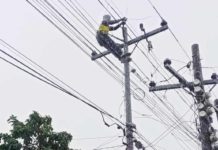ILOILO City – Policemen in Western Visayas may soon be using body cameras for more transparent operations.
The Philippine National Police (PNP) procured body-worn cameras and would distribute these to personnel of the Police Regional Office 6 (PRO-6), according to PNP spokesperson Brigadier General Ildebrandi Usana.
“As soon as we finish the technical requirements…hindi kasi madali ang pag-release. Maraming dapat ayusin,” Usana told Panay News.
Among others, he added, the use of body cameras would address supposed lapses in police operations.
DELAYED PROJECT
The last time the public heard about body cameras for the country’s police force was October last year when some 2,600 units purchased were supposed to be tested.
The mandatory use of body cameras in police operations has long been delayed – proposed in 2017 following the police killing of 17-year-old Kian delos Santos, funded after Congress approved a P334 million budget in 2018, and awarded to a contractor in 2019.
To fast-track the use of body cams during police operations, several senators called for the immediate passage of Senate Bill 42, or The Body Camera Act that requires law enforcers to activate the devices at the beginning of operations or at the first reasonable opportunity when there is an immediate threat to life and safety.
Lawmakers from the House of Representatives’ Makabayan bloc also called for an investigation on the delay in the “purchase and use” of police body cameras.
Under House Resolution No. 1480, the Makabayan bloc pointed out that P334 million was allocated for such under the 2018 national budget.
FACE OF TERROR
In Western Visayas, accusations of abuses against the police intensified after the raids in Tapaz, Capiz and Calinog, Iloilo on Dec. 30, 2020.
The targets were the Tumandok “red-tagged” or linked to the communist armed movement as supporters or members.
Police and military officials, however, maintained that those killed were leaders of the underground movement.
The Criminal Investigation and Detection Group Region 6, which led the operations, insisted that those who died fired first at police operatives who were serving a total of 28 search warrants for illegal firearms and explosives.
They also pointed out that Tapaz was a “center of gravity” of the rebel movement in Panay Island where government troops and policemen have died in rebel attacks since the 1970s.
But the families of those killed and several village officials refuted these claims. They said firearms were “planted” and those killed were unarmed and gunned down.
Last month, the Police Regional Office 6’s Regional Internal Affairs Service (RIAS) launched its own investigation.
CLEAR DOUBTS
Police Lieutenant Colonel Joem Malong, PRO-6 spokesperson, said body cameras would ensure the integrity of police antidrug operations, too.
These devices, according to Malong, would hold erring law enforcers accountable and at the same time, disprove false accusations.
She further explained the body cameras were good not only for the police but for drug suspects, too, because what happens during the operation would be fully recorded.
The recordings could be reviewed should there be questions about the operation.
Policemen could also use the recordings to defend themselves should they be hauled to court or to the National Police Commission, Malong said./PN



